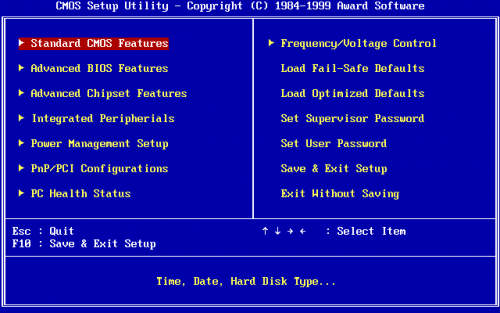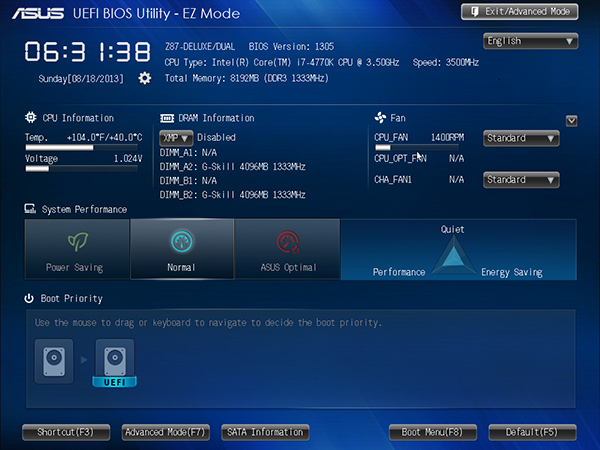What is UEFI?
For many years, all computers came with a BIOS. This was so named because it was the Basic Input-Output System. The BIOS is actually stored on a chip on the motherboard.
What is the BIOS?
The job of the BIOS is to immediately activate as soon as the computer is powered up, wake up the computer components, and verify that the required components are both present and functioning. If there is a problem, often the BIOS will send a message to the computer speaker to emit a series of beeps indicating a major hardware problem and the system cannot start at all. If everything is okay, the BIOS hands off to the boot-loader which will either present a menu of different installed operating systems or begin loading the single operating system that is installed.
The BIOS also has an installed menu system where the computer user can select to enter the BIOS menu, view the details of the hardware on the system, and make any changes they deem necessary at that time. BIOS either uses EEPROM flash memory or CMOS to store information relating to the BIOS functionality.
BIOS is limited to 16-bit operations, 1 MB of address space, and makes use of the Master Boot Record (or MBR) to organize the partition table for the computer. This refers to which physical hard drives and partitions are present, and in what order the system should attempt to boot through them. Settings with booting up via the BIOS can include whether to try booting to a CD, DVD or USB flash drive before attempting to boot from the main hard drive or partition.
Learn more about the basics of the BIOS in our other article.
What Is UEFI?
The UEFI (Unified Extensible Firmware Interface) has been created in conjunction with 140 technology companies via the UEFI consortium to replace the BIOS with something entirely more modern. It was originally developed by Intel alone for their Enterprise-targeted 64-bit Itanium-based servers, but it was later given over to the Unified EFI Forum who further developed it into UEFI.
It is a new way that a personal computer can boot-up which includes improved security from bootkits that can infect the startup process of a computer and prevent a PC from being usable at all once infected.
With PCs that are being sold with Windows, any computer with a logo sticker for Windows Certification Program that includes Windows Windows 8.1 or Windows RT 8.1 will be using UEFI rather than BIOS for its pre-startup and pre-boot process.
Much Improved Graphical Front-end With UEFI
The general appearance of the UEFI present in a new PC will vary dramatically from supplier to supplier. The graphical abilities of modern computers ensure that the supplied UEFI can include better visuals rather than an all ASCII text display as was the case with the BIOS. A mouse can be used with the interface to make selections, the improved graphics make it much easier to see what you want to do, and individual OEMs can customize their own UEFI system to make it look like the customized UEFI was developed in-house even if it actually wasn't.
The Main Benefits to PCs with UEFI
One of the main benefits is that the UEFI can be locked down so that bootkit and other malware cannot infect the booting process any longer. A UEFI setup is intended to be more interoperable with other systems and removes the 1 MB address limitations present in the old BIOS software. The 64-bit firmware device drivers with a UEFI boot can address up to 17.2 billion gigabytes of memory which should future-proof sufficiently (there is also a 32-bit mode). The security changes protect the pre-startup and the pre-boot process from infection and manipulation by third party software.
A GUID Partition Table is used instead of the Master Boot Record (MBR). This removes the 4 partitions per physical disk limitation, as well as the 2.2 TB bootable disk size limitation too. Instead, Globally Unique IDs are used to address disk partitions. The booting hard drive can be as large as 9.4 ZB (Zetabytes) which is technically 1024 x 1024 x 1024 GB's.
A UEFI is not proprietary so it can work with different file systems and operating systems. Network capabilities at startup are improved. The traditional boot loader which either launches an operating system or offers a list of installed operating systems to choose to boot to may still be used as an extension of the primary UEFI functionality. Alternatively, a UEFI can also run as a boot loader to keep things even simpler. UEFI allows for faster bootup times and a better speed when resuming from hibernation within Windows. It can also be used with existing systems that incorporate a BIOS rather than be to the exclusion of them (UEFI boot will be the primary system, the BIOS will be a secondary one).
UEFI will also support extensions like ACPI which removes the anonymous beeping when a hardware component is either not working correctly or is not slotted into the motherboard completely flush. Instead, a far more thorough test can be applied on the component in order to provide more useful feedback to help figure out what the actual booting problem is.
Secure Boot
The UEFI system also includes a "Secure Boot" feature. Secure Boot is an optional feature which can be enabled (or left disabled) by the manufacturer or OEM for the laptop or desktop computer. This is because not only can the UEFI system lock out changes that malicious bootkits and other spyware tries to do, but it will also prevent other changes to the main operating system or boot loader as well. As a result, this can prevent the installation of other operating systems for a dual booting environment that includes Windows 7 and flavors of the Linux operating system.
Each operating system needs to be updated in order to work in a friendly way with UEFI and the Secure Boot process. Operating systems still in development will likely be updated so that they can be recognized as a valid operating system installation and not get locked out as possible malware, whereas older ones no longer in development most likely will be unable to install with a PC that is using UEFI.
As more motherboard manufacturers choose to make the switch to UEFI on their motherboards instead of using the old BIOS system, PC buyers will see UEFI or “Secure Boot” installed with a very different booting process as a result. The improved security from the growing threat of bootkit malware makes this a change that couldn't have come at a better time.



